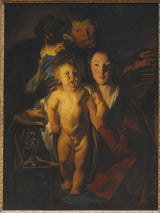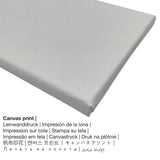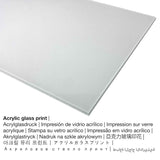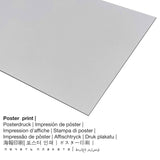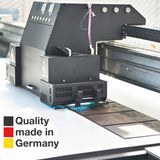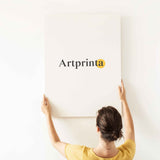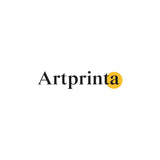Jacob Jordaens, 1622 - Familia Takatifu - chapa nzuri ya sanaa
Kodi ni pamoja. Usafirishaji umehesabiwa katika Checkout.
Background information on the artpiece created by the old master named Jacob Jordanens
hii 17th karne uchoraji wenye kichwa Familia Takatifu ilichorwa na mchoraji wa baroque Jacob Jordanens in 1622. Kazi ya sanaa hupima saizi: Urefu: 122 cm (48 ″); Upana: 92 cm (36,2 ″) Iliyoundwa: Urefu: 150 cm (59 ″); Upana: 120 cm (47,2 ″); Kina: 13 cm (5,1 ″) and was painted with oil. The work of art is in the the digital collection of Makumbusho ya Taifa ya Stockholm. Hii sanaa ya classic mchoro, ambayo iko katika Uwanja wa umma inatolewa kwa hisani ya Makumbusho ya Taifa ya Stockholm & Wikimedia Commons.Creditline ya kazi ya sanaa:. Zaidi ya hayo, upatanishi wa uzazi wa kidijitali uko ndani picha ya umbizo lenye uwiano wa upande wa 3: 4, meaning that the length is 25% shorter than the width. The painter Jacob Jordaens was an artist from the Netherlands, whose style was mainly Baroque. The Dutch artist lived for a total of miaka 85 - born in 1593 and deceased in the year 1678 in Antwerp.
Chagua chaguo lako la nyenzo za uchapishaji wa sanaa
In the dropdown selection next to the product you can select your individual size and material. We allow you to pick your favorite size and material among the following product individualization options:
- Turubai: A printed canvas material mounted on a wooden frame. A canvas print has the advantage of being relatively low in weight, which means that it is easy and straightforward to hang up the Canvas print without any wall-mounts. That is why, a canvas print is suited for any type of wall.
- Mchapishaji wa dibond ya Alumini: These are metal prints on aluminium dibond with an outstanding depth effect, which creates a modern impression by having a surface , which is non-reflective. The colors are luminous, the fine details are clear and crisp. The print on Aluminum Dibond is the most popular entry-level product and is a stylish way to showcase art prints, since it puts 100% of the viewer’s focus on the image.
- Chapisho la bango kwenye nyenzo za turubai: The poster print is a UV printed sheet of flat cotton canvas paper with a slightly rough surface structure. A poster print is suited for putting the art copy in a custom-made frame. Please bear in mind, that depending on the size of the poster print we add a white margin of something between 2 - 6cm round about the print in order to facilitate the framing with your custom frame.
- Chapisha kwenye glasi ya akriliki (na mipako halisi ya glasi juu): The print on acrylic glass, often labelled as a plexiglass print, changes your favorite original work of art into beautiful wall decoration. The work of art is being made thanks to state-of-the-art UV print machines. It creates stunning, vivid color tones. Our plexiglass with real glass coating protects your custom fine art print against sunlight and external influences for up to 6 decades.
Ujumbe muhimu wa kisheria: We try our best in order to depict the products as clearly as possible and to exhibit them visually on the respective product detail pages. Please bear in mind that the colors of the printing material, as well as the imprint can vary to a certain extent from the representation on the screen. Depending on your settings of your screen and the quality of the surface, colors might not be printed 100% realistically. Since all the art prints are processed and printed by hand, there might as well be minor deviations in the size and exact position of the motif.
Bidhaa
| Uainishaji wa uchapishaji: | ukuta sanaa |
| Njia ya uzazi: | uzazi wa kidijitali |
| Mbinu ya utengenezaji: | Uchapishaji wa moja kwa moja wa UV (uchapishaji wa dijiti) |
| viwanda: | Uzalishaji wa Ujerumani |
| Aina ya hisa: | juu ya mahitaji |
| Bidhaa matumizi: | sanaa ya ukuta, mkusanyiko wa sanaa (reproductions) |
| Mwelekeo: | mpangilio wa picha |
| Kipengele uwiano: | 3: 4 urefu: upana |
| Maana ya uwiano wa picha: | urefu ni 25% mfupi kuliko upana |
| Chaguo zilizopo: | chapa ya bango (karatasi ya turubai), chapa ya chuma (dibond ya alumini), chapa ya turubai, chapa ya glasi ya akriliki (iliyo na mipako halisi ya glasi) |
| Chaguzi za turubai kwenye fremu ya machela (kuchapishwa kwa turubai): | 30x40cm - 12x16", 60x80cm - 24x31", 90x120cm - 35x47", 120x160cm - 47x63" |
| Chapa ya glasi ya akriliki (iliyo na mipako halisi ya glasi) anuwai: | 30x40cm - 12x16", 60x80cm - 24x31", 90x120cm - 35x47", 120x160cm - 47x63" |
| Ukubwa wa bango (karatasi ya turubai): | 30x40cm - 12x16", 60x80cm - 24x31", 90x120cm - 35x47" |
| Chaguzi za uchapishaji wa Dibond (nyenzo za alumini): | 30x40cm - 12x16", 60x80cm - 24x31", 90x120cm - 35x47" |
| Muundo wa mchoro wa sanaa: | bila sura |
Data ya kazi ya sanaa iliyopangwa
| Kichwa cha kazi ya sanaa: | "Familia Takatifu" |
| Uainishaji wa kazi za sanaa: | uchoraji |
| Neno la jumla: | sanaa ya classic |
| Uainishaji wa muda: | 17th karne |
| mwaka: | 1622 |
| Umri wa kazi ya sanaa: | zaidi ya miaka 390 |
| Mchoro wa kati wa asili: | mafuta |
| Saizi asili ya mchoro: | Urefu: 122 cm (48 ″); Upana: 92 cm (36,2 ″) Iliyoundwa: Urefu: 150 cm (59 ″); Upana: 120 cm (47,2 ″); Kina: 13 cm (5,1 ″) |
| Makumbusho: | Makumbusho ya Taifa ya Stockholm |
| Mahali pa makumbusho: | Stockholm, Kaunti ya Stockholm, Uswidi |
| Inapatikana kwa: | www.makumbusho ya kitaifa.se |
| Aina ya leseni ya uchoraji: | Uwanja wa umma |
| Kwa hisani ya: | Makumbusho ya Taifa ya Stockholm & Wikimedia Commons |
Kuhusu mchoraji
| Jina la msanii: | Jacob Jordanens |
| Jinsia ya msanii: | kiume |
| Raia: | dutch |
| Kazi za msanii: | mchoraji |
| Nchi ya msanii: | Uholanzi |
| Uainishaji: | bwana mzee |
| Mitindo ya sanaa: | Baroque |
| Umri wa kifo: | miaka 85 |
| Mwaka wa kuzaliwa: | 1593 |
| Mwaka wa kifo: | 1678 |
| Mji wa kifo: | Antwerpen |
Hakimiliki © - www.artprinta.com (Artprinta)
(© Hakimiliki - na Nationalmuseum Stockholm - Makumbusho ya Taifa ya Stockholm)
English: Jordaens’ down-to-earth rendering of the Holy Family embraces the most intimate qualities of Caravaggism. The lit candle held by a maidservant is supplemented by the light from the unseen fireplace at which Joseph warms his hands, situating the genre-like scene in the heart of winter, the season in which Jesus was born. Standing upright on Mary’s lap, the realistically portrayed Christ Child seeks the viewer’s attention, as if beckoning us to approach and join in the adoration. With motherly pride Mary presents Jesus. The knife in his right hand alludes to the Circumcision, the first occasion on which the Redeemer’s blood was shed for our sins, intended to encourage meditation on the Passion. Details of the iconography are derived from the visions of St Bridget of Sweden, who described the newborn Christ Child as the source of a bright supernatural light. Jordaens concretises this divine radiance emanating from the body of Jesus – “the light of the world” – as an unusually intense reflected light from the flame of the candle. Jordaens vardagliga gestaltning av den Heliga familjen avspeglar caravaggismens mest intima karaktär. Den genreartade scenen utspelar sig på vintern, tiden för Jesu födelse. Det tända vaxljuset i tjänstekvinnans hand kompletteras av en eldstad utanför bildrummet vid vilken Josef värmer sina frusna händer. Det realistiskt skildrade Jesusbarnet står i Jungfru Marias knä. Genom blicken söker han kontakt med betraktaren, som för att bjuda oss att komma närmare och ansluta i tillbedjan. Med moderlig stolthet visar Maria upp Jesusbarnet. Kniven i Jesusbarnets hand hänsyftar till omskärelsen, det första tillfället då Frälsaren utgjuter sitt blod för våra synder, och uppmanar därmed till begrundan av Kristi passion. Målningens ikonografi härrör delvis från den heliga Birgittas uppenbarelser. Hon beskrev det nyfödda Jesusbarnet – ”världens ljus” – som källan till ett starkt övernaturligt ljus. Jordaens konkretiserar här den gudomliga strålglansen i form av det intensiva reflekterade skenet från vaxljusets låga.

